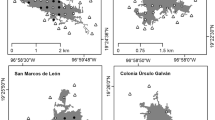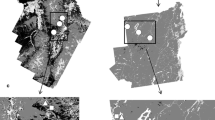Abstract
Invasive exotic species pose an important threat to biodiversity worldwide. However, there is little information on the effects that specific exotic bird species have on native biota. The House Sparrow is an excellent ecological model to evaluate the effect that an invasive exotic species has on native bird communities. Our study describes the relationship of the presence and abundance of House Sparrows with the structure, diversity, and composition of native bird communities in West Mexico. We used two approaches to compare House Sparrow invaded and non-invaded bird communities: (1) at a small geographic-scale that allowed us to evaluate shifts in avian communities with presence of the House Sparrow under similar environmental conditions; and (2) at the landscape-level to evaluate the effect of this species under a scenario of greater environmental heterogeneity. Results from both approaches show that areas invaded by House Sparrows have heavily-dominated avian communities with low species richness, while non-invaded areas exhibit highly-even and species-rich bird communities. Species turnover analysis indicates that the decrease in the number of bird species in House Sparrow invaded areas is caused by species loss, rather than a shift in species composition. Our results indicate that the invasion of an area by the House Sparrow, through synergistic interactions with human activities, determines the composition, structure, and diversity of native bird communities.




Similar content being viewed by others
References
Baker M (1995) Environmental component of latitudinal clutch-size variation in house sparrows (Passer domesticus). Auk 112:249–252
Blair RB (1996) Land use and avian species diversity along an urban gradient. Ecol Appl 6:506–519. doi:10.2307/2269387
Blair RB (2001) Birds and butterflies along urban gradients in two ecoregions of the United States: is urbanization creating a homogeneous avifauna? In: Marzluff JM, Bowman R, Donnelly R (eds) Avian ecology in an urbanizing world. Kluwer, Norwell
Bull J, Farrand J (1997) National audubon society field guide to North American birds—eastern region. Alfred A. Knopf, New York
Chace JF, Walsh JJ (2006) Urban effects on native avifauna: a review. Landsc Urban Plan 74:46–69. doi:10.1016/j.landurbplan.2004.08.007
Clergeau P, Savard JPL, Mennechez G, Falardeau G (1998) Bird abundance and diversity along an urban–rural gradient: a comparative study between two cities on different continents. Condor 100:413–425. doi:10.2307/1369707
Colwell RK (2005) EstimateS: statistical estimation of species richness and shared species from samples. Available online. http://purl.oclc.org/estimates
Cupul-Magaña FG (1996) Incidencia de avifauna en un parque urbano de los Mochis, Sinaloa, Mexico. Cienc ergo sum 3:193–200
Emlen JT (1974) An urban bird community in Tucson, Arizona: derivation, structure, regulation. Condor 76:184–197. doi:10.2307/1366729
Fritts TH, Rodda GH (1998) The role on introduced species in the degradation of island ecosystems: a case study of Guam. Annu Rev Ecol Syst 29:113–140. doi:10.1146/annurev.ecolsys.29.1.113
Gavareski CA (1976) Relation of park size and vegetation to urban bird populations in Seattle, Washington. Condor 78:375–382. doi:10.2307/1367699
Gavett AP, Wakeley JS (1986) Diets of House Sparrows in urban and rural habitats. Wilson Bull 98:137–144
Gotelli NJ, Colwell RK (2001) Quantifying biodiversity: procedures and pitfalls in the measurement and comparison of species richness. Ecol Lett 4:379–391. doi:10.1046/j.1461-0248.2001.00230.x
Gowaty PA (1984) House Sparrows kill Eastern Bluebirds. J Field Ornithol 55:378–380
Gritti ES, Smith B, Sykes MT (2006) Vulnerability of Mediterranean Basin ecosystems to climate change and invasion by exotic plant species. J Biogeogr 33:145–157. doi:10.1111/j.1365-2699.2005.01377.x
Grussing D (1980) How to control House Sparrows. Roseville Publication House, California
Hawkes CV, Wren IF, Herman DJ, Firestone MK (2005) Plant invasion alters nitrogen cycling by modifying the soil nitrifying community. Ecol Lett 8:976–985. doi:10.1111/j.1461-0248.2005.00802.x
Huff MH, Bettinger KA, Ferguson ML, Brown MJ, Altman B (2000) A habitat-based point-count protocol for terrestrial birds, emphasizing Washington and Oregon. US Department of Agriculture, Portland
Kalinoski R (1975) Intra- and interspecific aggression in House Finches and House Sparrows. Condor 77:375–384. doi:10.2307/1366086
Kark S, Iwaniuk A, Schalaimtzek A, Banjer E (2007) Living in the city: can anyone become an ‘urban exploiter’? J Biogeogr 34:638–651. doi:10.1111/j.1365-2699.2006.01638.x
Kimball RT (1997) Male morphology and nest-site quality in House Sparrows. Wilson Bull 109:711–719
Lennon JJ, Koleff P, Greenwood JJD (2001) The geographical structure of British bird distributions: diversity, spatial turnover and scale. J Anim Ecol 70:966–979. doi:10.1046/j.0021-8790.2001.00563.x
López E, Bocco G, Mendoza M, Duhau E (2001) Predicting land-cover and land-use change in the urban fringe: a case in Morelia city, Mexico. Landsc Urban Plan 55:271–285. doi:10.1016/S0169-2046(01)00160-8
MacGregor-Fors I, Morales-Pérez L, Schondube JE (in press) From forests to cities: effects of urbanization on subtropical mountain bird communities. Stud Avian Biol
Magurran AE (2004) Measuring biological diversity. Blackwell, Oxford
McAleece N (1997) BiodDversity Professional. Available online. http://www.sams.ac.uk/activities/downloads/downloads.htm
McGillivray WB (1980) Communal nesting in the House Sparrow. J Field Ornithol 51:371–372
McKinney ML (2002) Urbanization, biodiversity, and conservation. Bioscience 52:883–890. doi:10.1641/0006-3568(2002)052[0883:UBAC]2.0.CO;2
McKinney ML (2006) Urbanization as a major cause of biotic homogenization. Biol Conserv 127:247–260. doi:10.1016/j.biocon.2005.09.005
Moreno CE (2001) Métodos para medir la biodiversidad. M&T-Manuales y Tesis SEA, Zaragoza
Ralph CJ, Geupel GR, Pyle P, Martin TE, DeSante DF, Milá B (1996) Manual de métodos de campo para el monitoreo de aves terrestres. US Department of Agriculture, Albany
Robinson RA, Siriwardena GM, Crick HQP (2005) Size and trends of the House Sparrow Passer domesticus population in Great Britain. Ibis 147:552–562. doi:10.1111/j.1474-919x.2005.00427.x
Shaw L, Chamberlain D, Evans M (2008) The House Sparrow Passer domesticus in urban areas: reviewing a possible link between post-decline distribution and human socioeconomic status. J Ornithol 149:293–299. doi:10.1007/s10336-008-0285-y
Sibley DA (2001) The Sibley guide to birds. Alfred A. Knopf, New York
Smith MD, Knapp AK (2001) Size of the local species pool determines invasibility of a C4-dominated grassland. Oikos 91:55–61. doi:10.1034/j.1600-0706.2001.920107.x
Vitousek PM, D’Antonio CM, Loope LL, Rejmánek M, Westbrooks R (1997) Introduced species: a significant component of human-caused global change. N Z J Ecol 21:1–16
White JG, Antos MJ, Fitzsimons JA, Palmer GC (2005) Non-uniform bird assemblages in urban environments: the influence of streetscape vegetation. Landsc Urban Plan 71:123–135. doi:10.1016/j.landurbplan.2004.02.006
Wichman BA, Hill ID (1982) Algorithm AS 183: an efficient and portable pseudo-random number generator. Appl Stat 31:188–190. doi:10.2307/2347988
Wilson SD, Belcher JW (1989) Plant and bird communities of native prairie and introduced Eurasian vegetation in Manitoba, Canada. Conserv Biol 3:39–44
Zaret TM, Paine RT (1973) Species introduction in a tropical lake. Science 182:449–455. doi:10.1126/science.182.4111.449
Acknowledgments
We thank Carlos A. Chávez-Zichinelli, Mónica V. Orduña, and Nubia Medina for assistance in the field. Dr Katherine Renton, Dr Po and two anonymous reviewers greatly enriched the structure and content of our manuscript. Research funds were granted to J.E.S. by the Megaproyecto: Manejo de Ecosistemas y Desarrollo Humano—Universidad Nacional Autónoma de México (SDEI-PTID-02), and PAPIIT Project (IN228007-3). I.M-F., as part of the Posgrado en Ciencias Biológicas of the Universidad Nacional Autónoma de México, received a Master’s scholarship from CONACYT (203142) for his Master’s Degree project (203142). J.Q. was supported by a Grant for Foreign Researchers from the Secretaría de Relaciones Exteriores de México.
Author information
Authors and Affiliations
Corresponding author
Rights and permissions
About this article
Cite this article
MacGregor-Fors, I., Morales-Pérez, L., Quesada, J. et al. Relationship between the presence of House Sparrows (Passer domesticus) and Neotropical bird community structure and diversity. Biol Invasions 12, 87–96 (2010). https://doi.org/10.1007/s10530-009-9432-5
Received:
Accepted:
Published:
Issue Date:
DOI: https://doi.org/10.1007/s10530-009-9432-5




